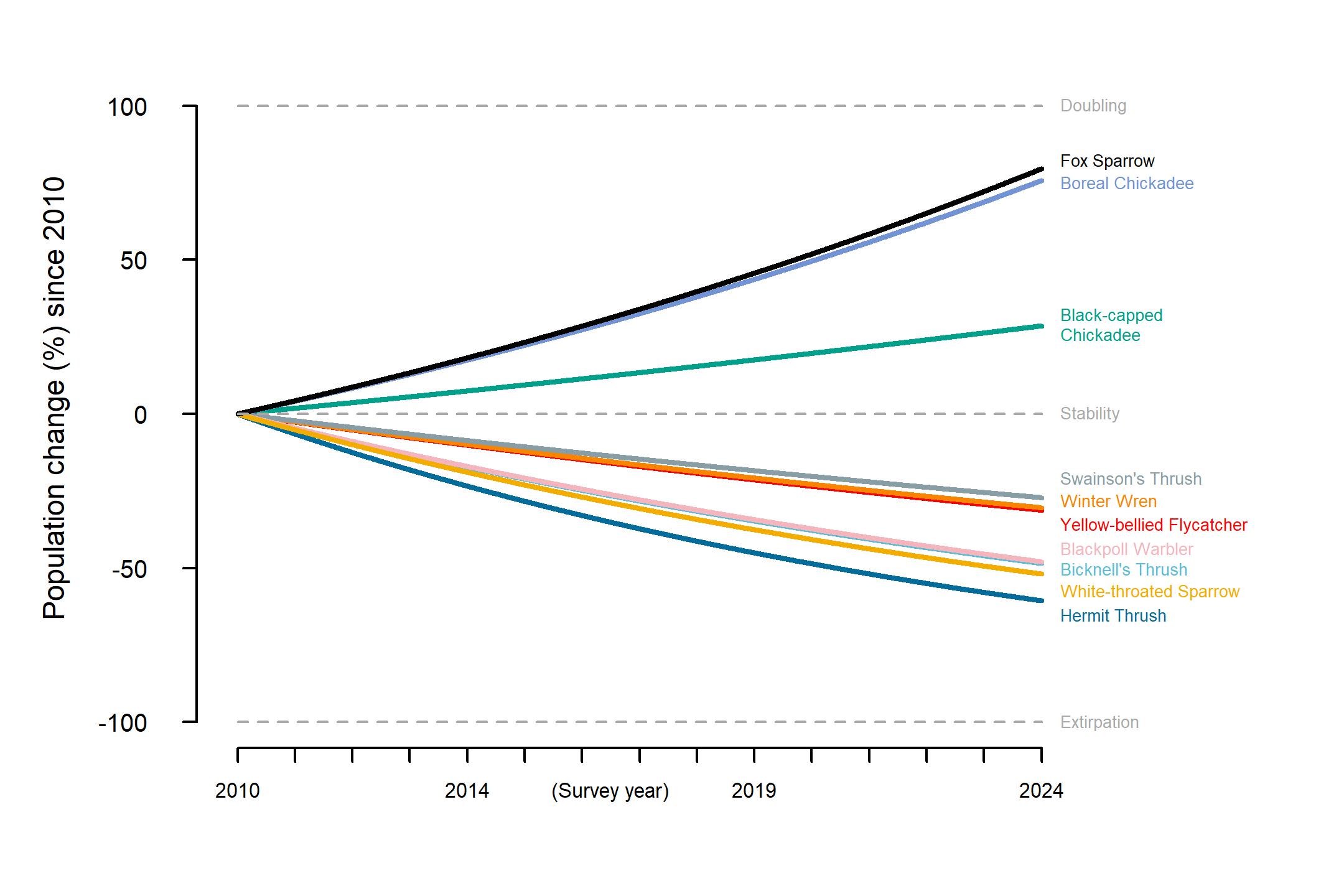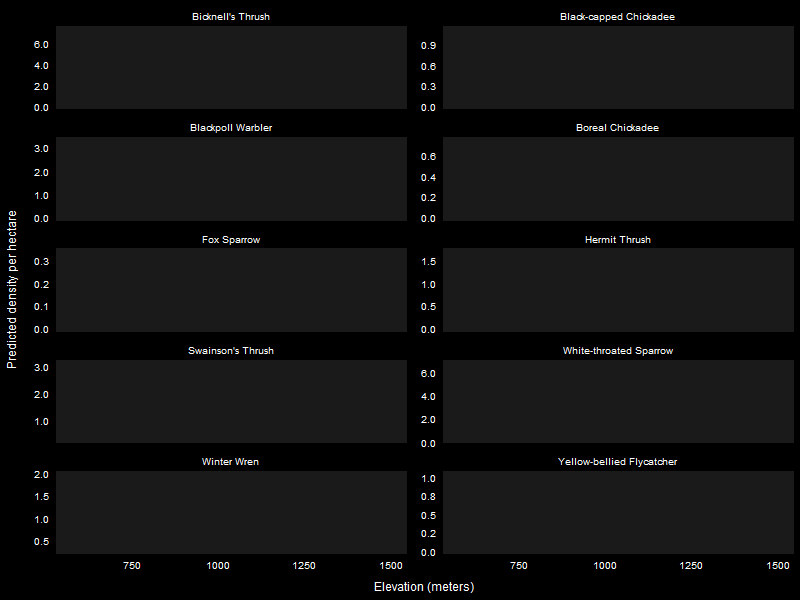Fourteen years of monitoring by many hundreds of community scientists has revealed that our mountain birds face challenging times in the northeastern United States. Our research continues to shed light on the underlying driving forces behind these declines, but anthropogenic climate change in our mountains is likely a root source of this problem. Mountain Birdwatch purposefully monitors ten bird species in the spruce-fir zone; these species are a mix of montane specialists (e.g., Blackpoll Warbler), intermediaries that occur in the lower hardwoods and spruce-fir (e.g., Swainson’s Thrush), and lower elevation species that are likely to colonize higher elevation areas as the climate warms and as humans further modify the landscape (e.g., Black-capped Chickadee). Our annual monitoring of approximately 800 montane locations reveals that most of the species that we monitor (Yellow-bellied Flycatcher, Winter Wren, Bicknell’s Thrush, Swainson’s Thrush, Hermit Thrush, Blackpoll Warbler, and White-throated Sparrow) have declined by an average of 42% since 2010. The most persistent declines continue to occur in the Catskills (at the southern periphery of the northeastern spruce-fir zone), where 7 of the 8 monitored bird species declined by an average of 55% since 2010. Note, Fox Sparrow and Boreal Chickadee do not breed in the Catskills, and only Black-capped Chickadees increased there.

The estimated percent population change between 2010 and 2024 for all 10 focal bird species monitored via Mountain Birdwatch throughout the Northeast. Positive values above the dashed line for stability indicate a population increase, while negative values indicate a decline compared to 2010. For example, an increase of 100% indicates a doubling of the population size since 2010. These lines represent the mean population change, when in reality the population of these species fluctuates each year. However, a figure showing those patterns (i.e., with zip-zagging lines) would be difficult to read and interpret. The credible intervals (a measure of each species’ uncertainty) are omitted for clarity. Click to enlarge.
The 2024 report is alarming, because it indicates continued declines of greater than 50% since 2010 for both Hermit Thrush and White-throated Sparrow—two species that are declining essentially everywhere they breed in the United States. Many species’ distribution models have predicted that species whose core populations occur at mid-elevations (e.g., Swainson’s and Hermit Thrush) may temporarily benefit from climate change by following warming patterns to higher elevations as their preferred climate envelope shifts upslope into newly-suitable(-to-them) habitat. That most of the mid-elevation and spruce-fir bird species show declining trends, suggests that there may be actually be fewer species than hypothesized that are poised to benefit from climate disruption at higher elevations.

An animation showing the relationship between elevation and abundance for 10 Mountain Birdwatch bird species. The electric blue line represents the mean prediction, while the purple lines show less-likely relationships. Click to enlarge.
| Species | Mean annual trend (%) | Trend (80% CRI) | Probability of decrease | Probability of increase | Population change (%) 2010-2024 | Population change (80% CRI) |
|---|---|---|---|---|---|---|
| Yellow-bellied Flycatcher | (-3.26, -1.17) | 0.99 | 0.01 | -25.27 | (-35.01, -14.23) | |
| Black-capped Chickadee | (-1.17, 5.60) | 0.20 | 0.80 | 33.07 | (-14.16, 102.96) | |
| Boreal Chickadee | (0.66, 6.05) | 0.05 | 0.95 | 52.27 | (8.91, 114.49) | |
| Winter Wren | (-4.50, -0.85) | 0.96 | 0.04 | -29.90 | (-45.05, -10.45) | |
| Bicknell's Thrush | (-5.20, -3.49) | >0.99 | <0.01 | -43.91 | (-50.06, -37.00) | |
| Swainson's Thrush | (-2.91, -1.17) | 0.99 | 0.01 | -23.48 | (-31.86, -14.17) | |
| Hermit Thrush | (-9.36, -4.54) | >0.99 | <0.01 | -60.83 | (-72.12, -45.35) | |
| Blackpoll Warbler | (-5.18, -3.80) | >0.99 | <0.01 | -44.95 | (-49.89, -39.58) | |
| White-throated Sparrow | (-6.09, -3.84) | >0.99 | <0.01 | -48.44 | (-55.84, -39.89) | |
| Fox Sparrow | (2.97, 9.81) | 0.05 | 0.95 | 124.08 | (46.21, 237.40) | |
| Red Squirrel | (2.33, 15.50) | 0.04 | 0.96 | 195.82 | (-13.49, 845.90) |
All bird species and population segments that nest within the high elevation spruce-fir zone, however, are highly susceptible to the effects of global climate change. As temperatures continue to rise this century, quantitative ecologists predict that boreal species will shift their breeding ranges upslope and poleward. By the end of this century, it is likely that the breeding ranges of dozens of our spruce-fir forest breeders (e.g., both crossbill species, Canada Jay, and Bay-breasted and Blackpoll Warblers) will be entirely restricted to the boreal forests of Canada and Alaska. Check out Audubon’s Survival by Degrees website to interact with these climate and species’ distribution models.
You can find the remainder of the 2024 report (e.g., more species-specific results, Methods, and Conservation Implications) via the web pages linked to the menu headings atop each page. If you find this report useful, please cite it (see sidebar for suggested citation) and the open access data and drop me a line (Jason Hill, ) to let me know how you used these data. Thank you.


